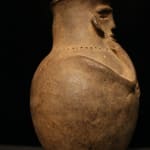Anthropomorphic Vessel, 20th Century CE
14.5
DC.349 (LSO)
Further images
This anthropomorphic vessel is a superbly manufactured and amusing piece of African art. It is also highly unusual – the level of dynamism and activity (not to mention asymmetry) in...
This anthropomorphic vessel is a superbly manufactured and amusing piece of African art. It is also highly unusual – the level of dynamism and activity (not to mention asymmetry) in its composition is remarkable and rare. The impression is of a fat man, the body of the vessel being his own body, narrowing to a spout that bears his face. A line of dots separates the two. His arms, which sprout from the gently sloping shoulders of the vessel, give way to hands that rest on the stomach and, coyly, on the right side of his chin. The face is incised into the neck, except for a T-bar forehead and nose complex that stand clear of the face. The ears and flange-like beard are the only other relief parts of the face.
This piece lacks comparatives. In terms of uniqueness, this is an admirable trait for the collector, although it poses certain problems in identification. The vertical scarifications on each cheek are traditionally Yoruba. The general form of the pot – excepting the apex – is Mangbetu, although most of their pots are female and usually have large, inverted cone-shaped coiffures. Pots of a not dissimilar style are known from the Tchokwe, but none in this particular form. It is clear, therefore, that it is not a traditional or standard design for any group, and that, given the ubiquitous nature of ceramics, that it is a mannerism of a talented ceramicist. If an attribution is required, the statistical probability lies with the Yoruba.
This piece lacks comparatives. In terms of uniqueness, this is an admirable trait for the collector, although it poses certain problems in identification. The vertical scarifications on each cheek are traditionally Yoruba. The general form of the pot – excepting the apex – is Mangbetu, although most of their pots are female and usually have large, inverted cone-shaped coiffures. Pots of a not dissimilar style are known from the Tchokwe, but none in this particular form. It is clear, therefore, that it is not a traditional or standard design for any group, and that, given the ubiquitous nature of ceramics, that it is a mannerism of a talented ceramicist. If an attribution is required, the statistical probability lies with the Yoruba.





